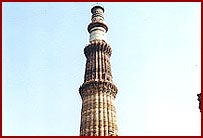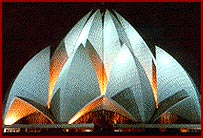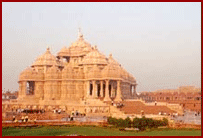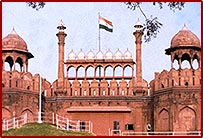Birla Mandir: This is one of the landmarks in New Delhi
- the capital of India. Built in the 20th century by the Birla family of
industrialists, it stands apart from other temples in terms of concept and
construction. The presiding deity here is Lakshmi Narain (Vishnu). The highest
tower in the temple reaches a height of 165 feet while the ancillary towers
reach 116 feet.
The Geeta Bhavan, a hall is adorned with beautiful
paintings depicting scenes from Indian mythology. There is also a temple
dedicated to Buddha in this complex with fresco paintings describing his life
and work.
Qutub
Minar: Qutab-ud-din Aibak, the first Muslim ruler of Delhi, commenced
the construction of the Qutub Minar in 1193 AD. The development of architectural
styles from Aibak to Tuglak are quite evident in the minar.
 The 238 feet high Qutub Minar is
47 feet at the base and tapers to 9 feet at the apex. The main mosque comprises
an inner and outer courtyard, of which the inner one is surrounded by an
exquisite colonnade, the pillars of which are made of richly decorated
shafts.
The 238 feet high Qutub Minar is
47 feet at the base and tapers to 9 feet at the apex. The main mosque comprises
an inner and outer courtyard, of which the inner one is surrounded by an
exquisite colonnade, the pillars of which are made of richly decorated
shafts.
Among the ruins in the Qutub Complex, the Quwat ul Islam Masjid
is one of the most magnificent mosques in the world. The building material for
this mosque is provided by demolishing many Hindu and Jain Temples in this area.
Built in 1197, this mosque is one of the finest blend of Hindu and Islamic
architecture.
In
the courtyard of the Quwat ul Islam Masjid, is a 7m high Iron Pillar -
one of Delhi's most curious antiquities. Belonging to the Gupta Age, the pillar
contains Sanskrit inscriptions, which state its history.
 Lotus Temple: This gleaming white structure, shaped
like a Lotus, is made of marble, cement, dolomite and sand. Located on Bahapur
Hill, the Lotus Temple is meant for the worship of God, irrespective of caste,
creed, race or nation. Visitors are requested to maintain silence inside the
temple premises. A visit to the Bahai Temple also known as Lotus Temple is a
must both for the tourists and the people in search of peace and tranquillity.
Lotus Temple: This gleaming white structure, shaped
like a Lotus, is made of marble, cement, dolomite and sand. Located on Bahapur
Hill, the Lotus Temple is meant for the worship of God, irrespective of caste,
creed, race or nation. Visitors are requested to maintain silence inside the
temple premises. A visit to the Bahai Temple also known as Lotus Temple is a
must both for the tourists and the people in search of peace and tranquillity.
Iskcon
Temple: Iskcon Temple in Delhi is reputed as one of the largest
temple complexes in India. The elegantly built complex is located on a hill and
is dedicated to Lord Krishna and Radha. The hall of the temple is centrally
air-cooled with a capacity to accommodate about 1,500 people. There are
beautiful paintings of Russian artists on the different past times of Radha
Krishna, Sita, Ram, Laxman, Hanuman and Chaitanya Mahaprabhu.
The Akshardham Temple - is one of the
most recently built temples in Delhi. Constructed by the Bochasanvasi
Aksharpurushottam Swaminarayan Sanstha (BAPS), it is situated on the banks
of the River Yamuna. Delhi Akshar Dham Mandir was inaugurated in
Novenmber'05 in the presence of President APJ Abdul Kalam. It is spread over
an area of 100 acres and took about two years to complete. Akshardhaam
Temple of New Delhi is built in an architectural style similar to that of
the Akshardham temple of Gandhinagar in Gujarat, India. Its construction is
based on the ancient Sthaapatya shastras of India and it is built without
steel, entirely out of sandstone and marble.
 Approximately
234 ornate pillars, floral motifs, arches, exquisitely carved pavilions, 9
ornate domes, 20 quadrangle shikhars, a spectacular Gajendra Pith (plinth of
stone elephants), adorn this architectural wonder. There are 20,000 statues
inside Akshar Dham Mandir of Delhi of India's great sadhus, devotees,
acharyas and divine personas. Other features of the Akshardham Temple are an
IMAX theatre, a Swaminarayan temple, and an elaborate musical fountain. The
area around the temple building has been converted into manicured lawns with
beautiful water fountains.
Approximately
234 ornate pillars, floral motifs, arches, exquisitely carved pavilions, 9
ornate domes, 20 quadrangle shikhars, a spectacular Gajendra Pith (plinth of
stone elephants), adorn this architectural wonder. There are 20,000 statues
inside Akshar Dham Mandir of Delhi of India's great sadhus, devotees,
acharyas and divine personas. Other features of the Akshardham Temple are an
IMAX theatre, a Swaminarayan temple, and an elaborate musical fountain. The
area around the temple building has been converted into manicured lawns with
beautiful water fountains.
The main shrine of the New Delhi Akshardhaam temple houses the statue of
Lord Swaminarayan. There is an Akshardham Temple Monument to World Peace
inside the temple complex. Along with that, there is also a restaurant
modeled on the Ajanta and Ellora caves and an Ayurvedic bazaar. Combining
Rajasthani, Orrisan, Gujarati, Mughal and Jain temple architecture, the
mandir presents a magnificent sight. This temple is a major tourist
attraction and counts amongst the wonders of modern India.


 Delhi today is one of the most
elegant capitals in the world. Here one can see, the mingling of many cultures,
languages, tradition and peoples into one united Nation. Delhi welcomes both the
pleasure seeker and the mystic. “Lose yourself in Delhi” says Khushwant Singh,
for “You may find its soul and your own”.
Delhi today is one of the most
elegant capitals in the world. Here one can see, the mingling of many cultures,
languages, tradition and peoples into one united Nation. Delhi welcomes both the
pleasure seeker and the mystic. “Lose yourself in Delhi” says Khushwant Singh,
for “You may find its soul and your own”. Crowned by 3 onion domes and
tapering minarets made of marble and slate, this architectural beauty is also a
place of religious significance. The view from the top of the minarets is
excellent.
Crowned by 3 onion domes and
tapering minarets made of marble and slate, this architectural beauty is also a
place of religious significance. The view from the top of the minarets is
excellent.  GARDENS, which is open to public twice in a year, usually in February and
March.
GARDENS, which is open to public twice in a year, usually in February and
March. The 238 feet high Qutub Minar is
47 feet at the base and tapers to 9 feet at the apex. The main mosque comprises
an inner and outer courtyard, of which the inner one is surrounded by an
exquisite colonnade, the pillars of which are made of richly decorated
shafts.
The 238 feet high Qutub Minar is
47 feet at the base and tapers to 9 feet at the apex. The main mosque comprises
an inner and outer courtyard, of which the inner one is surrounded by an
exquisite colonnade, the pillars of which are made of richly decorated
shafts. Lotus Temple: This gleaming white structure, shaped
like a Lotus, is made of marble, cement, dolomite and sand. Located on Bahapur
Hill, the Lotus Temple is meant for the worship of God, irrespective of caste,
creed, race or nation. Visitors are requested to maintain silence inside the
temple premises. A visit to the Bahai Temple also known as Lotus Temple is a
must both for the tourists and the people in search of peace and tranquillity.
Lotus Temple: This gleaming white structure, shaped
like a Lotus, is made of marble, cement, dolomite and sand. Located on Bahapur
Hill, the Lotus Temple is meant for the worship of God, irrespective of caste,
creed, race or nation. Visitors are requested to maintain silence inside the
temple premises. A visit to the Bahai Temple also known as Lotus Temple is a
must both for the tourists and the people in search of peace and tranquillity.
 Approximately
234 ornate pillars, floral motifs, arches, exquisitely carved pavilions, 9
ornate domes, 20 quadrangle shikhars, a spectacular Gajendra Pith (plinth of
stone elephants), adorn this architectural wonder. There are 20,000 statues
inside Akshar Dham Mandir of Delhi of India's great sadhus, devotees,
acharyas and divine personas. Other features of the Akshardham Temple are an
IMAX theatre, a Swaminarayan temple, and an elaborate musical fountain. The
area around the temple building has been converted into manicured lawns with
beautiful water fountains.
Approximately
234 ornate pillars, floral motifs, arches, exquisitely carved pavilions, 9
ornate domes, 20 quadrangle shikhars, a spectacular Gajendra Pith (plinth of
stone elephants), adorn this architectural wonder. There are 20,000 statues
inside Akshar Dham Mandir of Delhi of India's great sadhus, devotees,
acharyas and divine personas. Other features of the Akshardham Temple are an
IMAX theatre, a Swaminarayan temple, and an elaborate musical fountain. The
area around the temple building has been converted into manicured lawns with
beautiful water fountains.